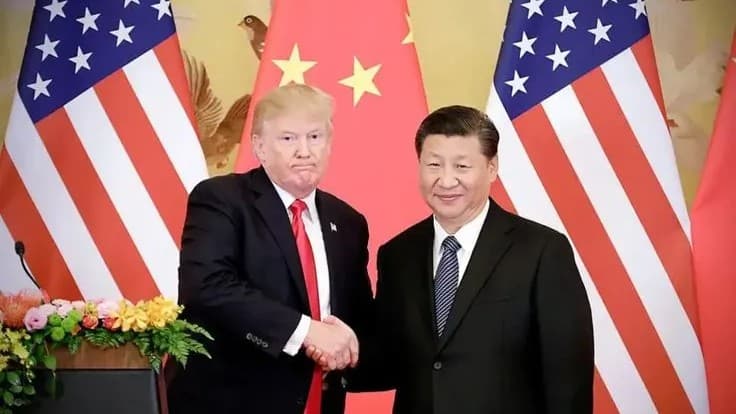14,000 Jobs Gone: Inside Amazon’s Corporate Restructuring and AI Investments
Amazon recently announced the layoff of approximately 14,000 corporate employees, representing around 4% of its workforce, as the company refocuses on efficiency and invests heavily in artificial intelligence (AI) and automation. During the pandemic, Amazon expanded its corporate staff significantly to meet rising demands, but the growing role of AI has reduced the need for some traditional roles. CEO Andy Jassy emphasized that while some jobs may decrease, new positions requiring advanced skills will emerge. The layoffs reflect a broader trend in the corporate world, with companies like Starbucks and Target making similar workforce adjustments. This strategic shift underscores Amazon’s commitment to long-term efficiency, technological advancement, and adapting human resources to the evolving global business and AI-driven landscape.

In a significant corporate move, Amazon, the American technology giant, has announced layoffs affecting approximately 14,000 corporate employees, accounting for nearly 4% of its total workforce. This decision comes as the company seeks to streamline its operations, invest heavily in Artificial Intelligence (AI), and better align resources with customer needs, both current and future. The move has sparked global attention and raised questions about the future of corporate jobs in the era of AI and automation.
The Reasons Behind Amazon’s Corporate Layoffs
Amazon’s workforce expanded significantly during the COVID-19 pandemic to meet the surge in e-commerce demand. Thousands of corporate roles were added to support logistics, cloud computing, and other corporate functions. However, as AI and automation technologies gain momentum, certain traditional corporate roles have become less critical.
In a note to employees, Amazon’s Human Resources Executive, Beth Galetti, explained that the layoffs were aimed at reducing bureaucracy, removing unnecessary layers, and reallocating resources to focus on the company’s biggest priorities. She emphasized that the company is committed to ensuring long-term growth and operational efficiency while continuing to meet customer expectations.
CEO Andy Jassy also highlighted the role of AI in transforming the corporate workforce. According to Jassy, AI and automation will reduce the need for some tasks currently performed by human employees while simultaneously creating new opportunities requiring advanced skills. He stated, “We will need fewer people doing some of the jobs that are being done today, and more people doing other types of jobs. It’s hard to know exactly where this nets out over time, but in the next few years, we expect that AI will reduce our total corporate workforce as we achieve efficiency gains from its widespread use.”
The Role of AI and Automation in Corporate Restructuring
Amazon is a dominant player in the cloud computing space through its Amazon Web Services (AWS) platform. Despite its leadership in cloud services, the company’s AI initiatives have not grown as rapidly as competitors like Microsoft. Reports indicate that AI-related projects are expanding, but the rate of growth is below market expectations.
The company’s strategy highlights a broader trend in the corporate sector: companies are increasingly leveraging AI and automation to optimize operations, improve efficiency, and reduce costs. Administrative tasks, repetitive workflows, and certain managerial functions are being automated, freeing human talent for strategic, creative, and decision-making roles.
Global Corporate Trends: A Wider Perspective
Amazon is not alone in taking such steps. Recent corporate restructuring trends indicate that cost optimization and organizational efficiency are now top priorities for global businesses. Examples include:
- Starbucks recently cut nearly 2,000 corporate jobs as part of its turnaround strategy in response to declining sales.
- Target announced the reduction of 1,800 corporate positions, reflecting its focus on operational restructuring and efficiency.
These moves illustrate that workforce realignment has become a common approach for companies facing economic pressures, technological disruption, and investor expectations.
Impact on Employees and Workforce Dynamics
The layoffs will directly affect the employees who are losing their positions. Amazon has promised severance packages, redeployment options, and training for new roles to mitigate the impact. Despite these measures, the changes are likely to affect employees’ families and local economies, as large-scale layoffs have both social and financial consequences.
Experts emphasize that these layoffs reflect a larger corporate realignment rather than a decline in overall employment opportunities. As some traditional roles are phased out, new positions demanding high-value skills in AI, data analytics, cybersecurity, and cloud technologies are emerging. Employees must adapt to a rapidly evolving corporate landscape by developing relevant technical and soft skills.
Future Outlook: AI, Automation, and Human Skills
The integration of AI and automation will significantly alter job structures. Companies will increasingly require employees with a mix of technical expertise and human-centric skills. Some anticipated trends include:
- Emerging Roles: AI trainers, data scientists, cloud computing specialists, cybersecurity experts, and innovation managers.
- Declining Roles: Routine administrative jobs, conventional corporate tasks, and repetitive process-driven roles.
- Human-Centric Skills in Demand: Critical thinking, creativity, leadership, and communication.
This transformation underlines the importance of balancing technological efficiency with human talent. Employees who develop hybrid skills will remain competitive and valuable in the AI-driven workplace.
Implications for Investors and Market Sentiment
Amazon’s strategy sends a strong signal to investors that the company is positioning itself for long-term competitiveness in AI and cloud computing. While short-term stock volatility may occur, these steps are likely to enhance operational efficiency and profitability over time.
Analysts note that investing in AI not only positions Amazon against competitors but also prepares it for a future where operational costs are optimized, and customer services are delivered faster and more effectively. Shareholders can expect stronger returns as Amazon capitalizes on technological advancements.
Economic and Corporate Policy Implications
The global adoption of AI and automation by corporations like Amazon also has broader implications for economic policies and corporate governance. These include:
- Reduced Operational Costs: AI-driven efficiencies lower production costs and improve service quality.
- Changing Job Structures: Traditional jobs are being replaced by technically specialized roles.
- Strategic Resource Allocation: Companies are increasingly restructuring to maximize efficiency and profitability.
- Competitive Advantage: Early adoption of AI provides a strategic edge in global markets.
Governments and policymakers must consider the effects of automation on employment, reskilling initiatives, and economic stability. Social safety nets, professional training programs, and educational reforms will be crucial in preparing the workforce for the AI-driven future.
The Broader Technological Context
Amazon’s corporate restructuring reflects a broader technological evolution. The convergence of AI, machine learning, and cloud computing is reshaping industries worldwide. Companies must innovate continuously to maintain relevance, and employees must evolve alongside technological advancements.
The adoption of AI is not merely a cost-cutting measure; it represents a strategic investment in long-term growth. By reallocating resources to AI and automation, Amazon aims to:
- Streamline corporate operations
- Increase productivity and efficiency
- Enhance customer experiences
- Drive innovation across business units
Human-Centered Technology: The Key to Success
Despite AI’s growing presence, human judgment, creativity, and decision-making remain irreplaceable. Companies that successfully integrate AI with human talent will be better positioned to adapt to market disruptions, anticipate customer needs, and drive sustainable growth.
Employees who cultivate a combination of technical proficiency and soft skills will continue to be indispensable. Businesses that invest in employee reskilling programs will maintain a competitive edge while minimizing workforce displacement.
Conclusion
Amazon’s decision to lay off 14,000 corporate employees underscores the transformative impact of AI and automation on the modern workplace. While challenging for affected employees, the move reflects a broader corporate strategy aimed at operational efficiency, technological advancement, and sustainable growth.
The layoffs highlight several critical lessons for businesses, employees, and investors alike:
- Corporate Agility: Organizations must adapt quickly to technological and market changes.
- Reskilling and Human Skills: Employees need continuous learning and skill upgrades to stay relevant.
- Strategic Investment: AI and automation can drive efficiency, innovation, and competitiveness.
- Global Workforce Transformation: Traditional job structures are evolving into high-value, specialized roles.
As Amazon continues to invest in AI and optimize its corporate structure, the company is not only reshaping its workforce but also setting a precedent for global businesses navigating the future of work. The convergence of technology, human talent, and strategic vision will define success in the AI-driven economy.
Frequently Asked Questions (FAQ) – Amazon Corporate Layoffs and AI Investment
Q1: Why is Amazon laying off 14,000 corporate employees?
Amazon is reducing its corporate workforce by around 14,000 employees, which accounts for about 4% of its total workforce. The company aims to reduce bureaucracy, streamline operations, and shift resources toward AI and other technology investments to better serve customer needs.
Q2: Which departments are affected by these layoffs?
The layoffs primarily affect corporate roles, including human resources, administrative functions, and other non-technical divisions. Amazon has not disclosed all specific departments but has emphasized workforce optimization.
Q3: How does AI play a role in Amazon’s workforce changes?
Amazon is heavily investing in AI and automation to increase efficiency. Some traditional corporate tasks that were previously done by humans can now be performed by AI systems, reducing the need for certain roles while creating demand for new technical skills.
Q4: Will employees receive support after the layoffs?
Yes. Amazon has stated that affected employees will receive severance packages, access to replacement opportunities, and training options to transition into new roles within or outside the company.
Q5: How do these layoffs compare to other companies?
Similar corporate workforce reductions have occurred at companies like Starbucks, which cut 2,000 jobs, and Target, which reduced 1,800 corporate positions. This trend reflects a larger global focus on efficiency and technological adaptation.
Q6: What new opportunities might arise due to AI and automation?
The rise of AI is expected to create roles in data analysis, AI training, cloud computing, cybersecurity, and other technology-focused positions. Skills like leadership, decision-making, creativity, and communication will remain highly valuable.
Q7: Will these layoffs impact Amazon’s financial performance?
While short-term market reactions may fluctuate, these strategic changes are expected to improve long-term operational efficiency, reduce costs, and enhance profitability as Amazon invests in AI and other growth areas.
Q8: How does this affect the global job market?
Amazon’s layoffs are part of a broader trend where AI and automation are reshaping global employment patterns. Traditional jobs may decrease, but new technology-driven roles and industries will emerge, requiring a shift in workforce skills.
Q9: How is Amazon balancing AI with human talent?
Amazon is focusing on a hybrid approach—using AI to handle repetitive tasks while human employees focus on creativity, leadership, strategy, and problem-solving. This ensures technological efficiency without fully replacing human insight.
Q10: What does this mean for investors and customers?
For investors, Amazon’s AI-focused restructuring signals long-term growth potential and competitive positioning. For customers, it could mean faster, more efficient services and innovative solutions driven by AI and automation.
Dhananjay Singh
Professional Content Writer, Researcher & Visionary Storyteller
"तरक्की को चाहिए नया नज़रिया—और यह नज़रिया शब्दों से शुरू होता है।"
More from Dhananjay Singh →

